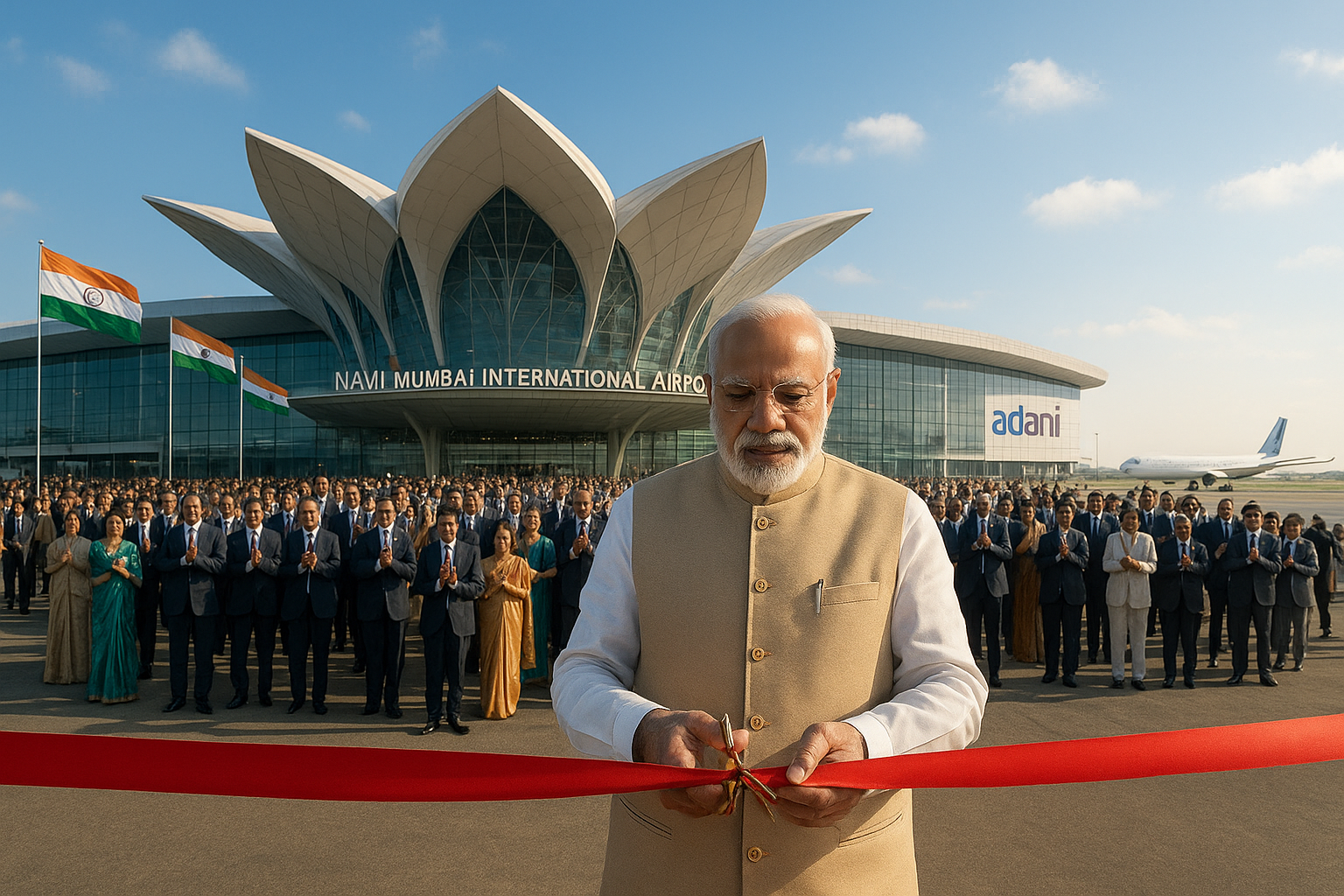October 8, 2025 marks a historic day for Maharashtra and India. On this day, Prime Minister Narendra Modi officially inaugurated the Navi Mumbai International Airport (NMIA) — one of India’s most advanced, eco-friendly, and technologically sophisticated airports.
Developed to ease air traffic from Mumbai’s congested Chhatrapati Shivaji Maharaj International Airport, NMIA represents India’s growing global ambitions in infrastructure, design, and sustainability.
✈️ Project Overview
The Navi Mumbai International Airport is being developed by Adani Airports Holdings Limited in collaboration with CIDCO (City and Industrial Development Corporation of Maharashtra).
Spread across 38 square kilometers, the airport is designed to be developed in multiple phases.
- Location: Ulwe, Navi Mumbai (near Panvel)
- Developer: Adani Group
- Phase 1 Capacity: 20 million passengers per year
- Full Capacity: 90 million passengers per year
🌆 Importance for Maharashtra and India
NMIA is not just an airport — it’s a symbol of India’s rising economic power.
With the Mumbai airport reaching saturation, Navi Mumbai’s new international airport will play a critical role in decongesting air traffic and supporting economic expansion across western India.
The airport will serve as a catalyst for real estate growth, job creation, and tourism development in nearby areas such as Panvel, Ulwe, Kharghar, Taloja, and Kalamboli.

🏗️ Architectural and Technological Features
Designed by Japan’s prestigious Nikken Sekkei Ltd., the Navi Mumbai International Airport reflects a blend of modern technology and Indian cultural inspiration.

Key Highlights:
- Terminal Design Inspired by the Lotus Flower
- Solar-Powered Operations & Zero Carbon Emission Policy
- Dual Parallel Runways
- AI-Based Security & Face Recognition Boarding
- Seamless Metro and Road Connectivity (via Navi Mumbai Metro & Mumbai Trans Harbour Link)
- Smart Terminal with paperless systems and sustainable materials
The airport aims to be one of Asia’s greenest aviation hubs, aligning with India’s carbon neutrality goals.
🪁 The Grand Inauguration Ceremony
The grand opening ceremony on October 8, 2025, was attended by several dignitaries, including:
- Prime Minister Narendra Modi
- Maharashtra Chief Minister Eknath Shinde
- Deputy CM Devendra Fadnavis
- Union Civil Aviation Minister Jyotiraditya Scindia
- Adani Group Chairman Gautam Adani
During his address, PM Modi stated that the Navi Mumbai International Airport will “give new wings to India’s development and connect the dreams of millions of people.”

🏡 Impact on Real Estate Market
The inauguration has already started transforming the real estate landscape of Navi Mumbai and surrounding areas.
Property experts predict that in the next 3 years, property prices in Ulwe, Panvel, Taloja, and Kharghar could appreciate by 20–30%.
Developers are launching new projects, and online property platforms like NayeGhar.com report a surge in demand for premium housing and commercial spaces in the NMIA region.
Popular projects like Sai World City, Marathon Nexzone, Gami Tiara, and Indiabulls Greens are seeing renewed buyer interest.
🛫 When Will Flights Begin?
Although the airport was inaugurated in October 2025, commercial operations are expected to begin by December 2025.
Once Phase 1 is operational, NMIA will handle up to 20 million passengers annually, gradually expanding to become one of the largest airports in India.
🌏 A Vision for the Future
Navi Mumbai International Airport is a shining example of the Make in India, Digital India, and Smart City Mission initiatives working together.
It’s designed to position India as a global aviation hub by 2047 — the year marking India’s goal of becoming a developed nation.

🔍 Conclusion
The inauguration of Navi Mumbai International Airport is not merely an infrastructure milestone — it’s a symbol of India’s confidence and capability.
It promises to boost air connectivity, tourism, trade, jobs, and real estate development across the Mumbai Metropolitan Region.
✨ “New Airport. New Opportunities. New India.” ✨
1. When was the Navi Mumbai International Airport inaugurated?
The Navi Mumbai International Airport (NMIA) was officially inaugurated on October 8, 2025, by Prime Minister Narendra Modi.
2. When will the first commercial flights start from NMIA?
According to official reports, commercial operations are expected to begin in December 2025, starting with domestic flights before expanding to international routes.
3. Who is developing the Navi Mumbai International Airport?
The airport is being developed by Adani Airports Holdings Limited (AAHL) in collaboration with CIDCO (City and Industrial Development Corporation of Maharashtra).
4. Where exactly is the airport located?
The Navi Mumbai International Airport is located at Ulwe, near Panvel, in Navi Mumbai, Maharashtra.
It is well-connected to Mumbai via the Mumbai Trans Harbour Link, Sion-Panvel Expressway, and Navi Mumbai Metro.5. What is the passenger handling capacity of NMIA?
- Phase 1: 20 million passengers per year
- Final Phase: Up to 90 million passengers per year
This makes NMIA one of the largest airports in India once fully operational.
6. How many runways does Navi Mumbai Airport have?
The airport features two parallel runways, allowing simultaneous take-off and landing to manage high traffic efficiently.
7. What are the unique features of NMIA?
- Eco-friendly, solar-powered operations
- Lotus-inspired architecture
- Zero Carbon Emission policy
- AI-based facial recognition and paperless boarding
- Integrated metro and highway connectivity
8. How will NMIA impact Navi Mumbai’s real estate market?
The inauguration has triggered a property boom in areas like Panvel, Ulwe, Kharghar, and Taloja.
Experts predict a 20–30% rise in property prices over the next few years due to increased demand and improved infrastructure.9. Who designed the airport?
The architectural design of NMIA was created by Nikken Sekkei Ltd., a renowned Japanese firm known for blending innovation with sustainability.
10. Why is Navi Mumbai Airport important for India?
NMIA will reduce congestion at Mumbai’s existing airport, boost tourism, create thousands of jobs, and strengthen India’s position as a global aviation hub.
It is also a major milestone under the Make in India and Smart City Mission programs.





